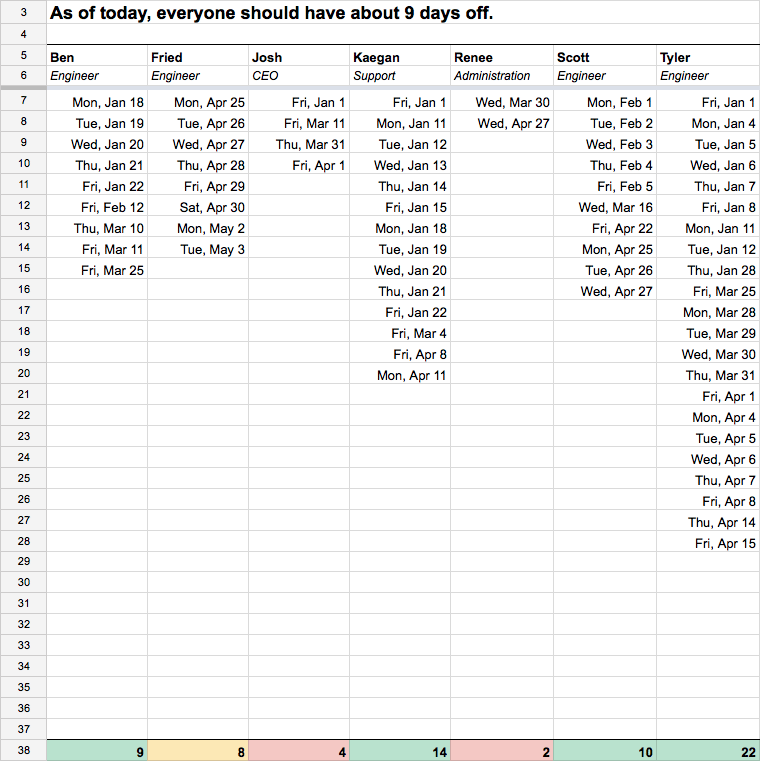Table of Contents

It’s a common startup benefit to have a “loose” or “unlimited” vacation policy. “Take all the time off you need!” “We don’t babysit you, take off whenever you need off!” But does anyone actually take off any more time than if they were working somewhere that had a “strict” or “limited” vacation policy?
My hunch was that if we said we had unlimited vacation then the lack of limits would prevent anyone from actually taking off enough time. They’d self-impose boundaries and instead end up taking off a lot less time than they should.
And it turns out, my hunch was pretty spot on.
Article after article covers the downsides of “unlimited” vacation. Turns out, humans need guidelines. They want boundaries or rules to follow. Order is a good thing.
So, with a clear message that unlimited isn’t great, how do we make sure the folks our team have the freedom to take care of themselves and their families and make sure they’re not working themselves into the ground?
Minimum Vacation
Putting a hard limit on vacation didn’t feel like the answer. Everyone has different life events that vary from month to month and year to year.
Marriages, adoptions, illnesses, births…every person won’t have all of these things every year (hopefully). Our hope is that the flexibility to do what you believe is best for you, your family and your ability to get your work done is something each person on our team is mature enough to handle.
So what we’ve decided to do is implement a minimum vacation policy: each team member is expected to take at least 4 weeks off throughout the year with at least one week-or-longer vacation.
Accountability
“Unlimited” tends to imply lack of accountability…do what you want, when you want, for however long you want. Instead, with our minimum policy, we track all time off.
We track days off to surface any trends and to ensure time off is being distributed and managed as fairly as possible (again, knowing that every team member is different).
As a CEO, tracking allows me to have a conversation when people aren’t taking enough time off. It also allows me to see if there is any correlation between time off and productivity and address any potential abuses of our vacation policy before they become a real problem.
Public Time Off Board
To make it easier for us to track all of this, we have an internal spreadsheet that the whole company can see.
It shows who has taken off when, how many days everyone should have taken off thus far and who’s on target for an appropriate amount of “minimum” vacation.
Everyone can see who has taken how much time off and we’ve found that it actually helps us keep each other in check on vacation…specifically with who isn’t taking enough time off.
We’ve now decided to make that internal spreadsheet available for everyone to see! You can see how much time off each team member has taken, along with if they’re on target or not.
Likewise, you can copy the spreadsheet and use it for your company as well!
The spreadsheet automatically tells how many days each team member should have taken off by now (assuming 28 vacation days) and visually highlights if they’re on target or not (green = good, yellow = cutting it close, red = take some time off!).
How this affects the team
As with any instance of making raw data public (whether internally or to the whole world) there are some pros and cons and unique ways this can affect teams.
Feeling guilty for taking too much time off
As you can see in our spreadsheet, Tyler has taken over double what most of the rest of the team has at this point. But like I mentioned before, every person has different circumstances and in this case, Tyler got married and went on a honeymoon. Literally no one in the company is mad that he did that.
In fact, I think the slight imbalance is actually a good thing as it helps others feel more freedom to take time off.
Seeing where you’re failing as a CEO
As we were putting this together, something became very clear: I’m doing a terrible job of leading my team in this area. I’ve taken a measly 4 days off in the past 4 months and if we tout “minimum vacation” then I should be leading the charge with regularly taking time off.
I owe it to me and my team to take care of myself.
What’s your policy?
What’s your policy at your company? How have you seen unlimited/loose vacation play out (negatively or positively)? What are some other setups that you’ve seen work well?




